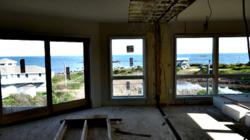Alexandria, Virginia (PRWEB) June 16, 2012
Are major hurricanes hardwired to occur within certain intervals or are visits random?
That question is critical to the millions of residents who live in the Middle Atlantic states.
Hazel in October 1954 was the last tropical cyclone to bring actual hurricane force winds of 74 mph and higher to large sections of the region. It made landfall in North Carolina before tracking north through Virginia, Maryland, Pennsylvania and New York; its unrelenting fury surprising those living well inland, making for lifetime memories. Hazel set many wind records, including a 78 mph sustained wind in Washington, D.C., and a peak gust of 98 mph.
The reference, Hurricanes and the Middle Atlantic States, published by Blue Diamond Books, details Hazel and many similar events.
Hazel-type storms have occurred regularly in the Mid-Atlantic region during the past 400 years. No gap before Hazel was longer than 58 years, with two intervals of 57 years and Hazel, which came 58 years after the highly destructive hurricane of 1896.
Never before have so many people and so much property been at risk, said Rick Schwartz, author of Hurricanes and the Middle Atlantic States. Extensive development since 1954 means increased vulnerability and likely one of the costliest hurricanes in U.S. history.
Past inland hurricanes, as I named them, Schwartz said, brought hurricane force winds along an interior track lasting hundreds of miles. Residents were astounded. They couldnt believe such an event possible.
Accounts in the book Hurricanes and the Middle Atlantic States read like fiction.
An observer at Stratford Hall along the lower Potomac River in Virginia wrote of the hurricane of September 1769, In short, had the storm continued for a few hours more the present view must satisfy every sensible person that this part of America would have ceased to exist.
A hurricane in October 1878 heavily damaged or destroyed 700 buildings in Philadelphia, Pennsylvania. In nearby Wilmington, Delaware, winds tore the roofs off 100 homes.
A reporter for the Washington Star said of the enormous damage from the hurricane of September 1896: Today the city bears the mark of the storm in so many quarters, and the ruins are so numerous, that to enumerate then (would be) an endless task.
The Mid-Atlantic region is particularly vulnerable to high winds. Leafy, shallow-rooted trees are easy prey for persistent gusts. Less wind resistant building design than in more hurricane-prone places also contributes to risk. Hurricane Isabel in 2003, for example, was downgraded to a tropical storm soon after reaching Virginia. Its winds still caused billions of dollars in losses as it tracked north.
All previous Hazel-type events occurred in September or October at the peak of the official hurricane season, which is from June 1 until November 30. Each tracked through North Carolina, Virginia and Maryland, with some moving into eastern Pennsylvania and others passing through Delaware and New Jersey.
Hurricanes such as these rank among the Middle Atlantic states most destructive natural disasters, Schwartz said. Yet, few residents are aware of them and what they have done. My research covered 400 years of Mid-Atlantic hurricane history and describes each. The region is undoubtedly due for the next Big One. Unfortunately, it appears that once again experience will be the teacher.
For historical hurricane information, contact Rick Schwartz, author of Hurricanes and the Middle Atlantic States, the first book to focus on the areas hurricane history, at 571-245-0318.
For more information about the hurricane history of the Middle Atlantic states, visit http://www.midatlantichurricanes.com. The site offers individual pages that summarize notable events in Delaware, Maryland, New Jersey, North Carolina, Pennsylvania and Virginia, as well as New York City. The section, Hurricane Perspective, offers insights into inland hurricanes.
Find More Interior Design Press Releases

